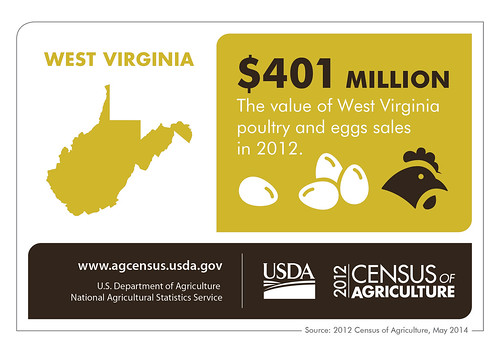
The Census of Agriculture is the most complete account of U.S. farms and ranches and the people who operate them. Every Thursday USDA’s National Agricultural Statistics Service will highlight new Census data and the power of the information to shape the future of American agriculture.
West Virginia’s climate and topography earned our state the Mountain State nickname. Our rugged mountains also ensure our agricultural community remains extremely diverse. Since West Virginia was admitted to the Union on June 20, 1863, farms have been the backbone of the state. According to the first agricultural census, conducted in West Virginia in 1870, there were 39,778 farms with 8,528,394 acres in production, with an average farm size of 214 acres. In the 2012 Census of Agriculture there were 21,480 farms in West Virginia with 3,606,674 acres in production, with an average farm size of 209 acres.
Unlike in many other states, West Virginia’s small farms (those farms selling less than $250,000 in agricultural products) account for nearly 29 percent of total farm sales in 2012, contrasting the US average of 11.1 percent. An even more telling statistic is that nearly half of sales of agricultural products were from farms selling less than $1,000,000, compared to the U.S. average of 33.6 percent. West Virginia has one of the highest ratios of small farms to total number of farms based on the 2012 Census of Agriculture.
There is a great deal of diversity in the type of agriculture products raised on our farms. West Virginia farmers produce:
- Beef cattle (250,073 cattle and calves sold);
- Broilers (93,749,081 sold);
- Corn (4.5 million bushels);
- Soybeans (over 1 million bushels);
- Vegetables (2,257 acres);
- And many other commodities
In 2012, sales of poultry and eggs were the highest grossing group of commodities at more than $401 million. West Virginia also ranks 11th in the nation in apple production. Berkely County, in the Eastern Panhandle, is the leading apple producing county in the state, and ranks 24th nationally. In addition to traditional agricultural commodities we even see farmers raising alpacas (108 farms with an inventory of 1,368 head) and llamas (102 farms with 415 head) in the Mountain state.
With the rising interest in organic and value added commodities, West Virginia is keeping up with the rest of the U.S. West Virginia’s small farms are increasing their sales of organically produced products. Production of value added commodities also increased during the same time period from 1,011 farms in 2007 to 1,322 in 2012. Farmers Markets, and other forms of marketing directly to consumers, continues to increase in value. In 2012, West Virginia farmers sold almost $11 million of fruits, vegetables, meats and other agricultural products directly to consumers.
These are just some of the exciting facts about West Virginia agriculture. For more data on our state’s production, check out our complete 2012 Census.
